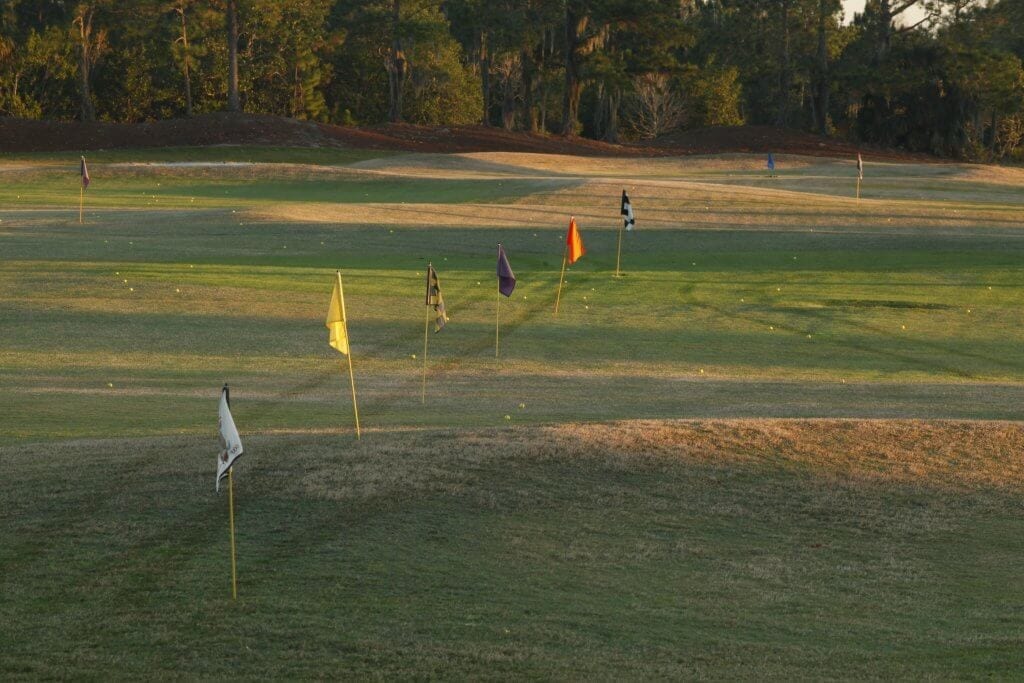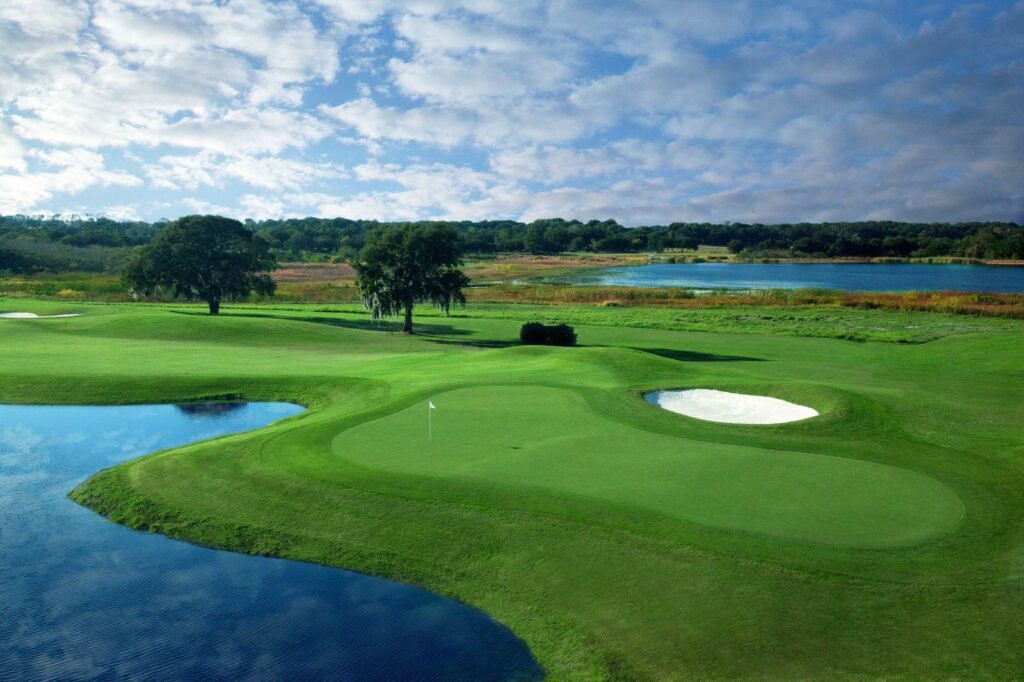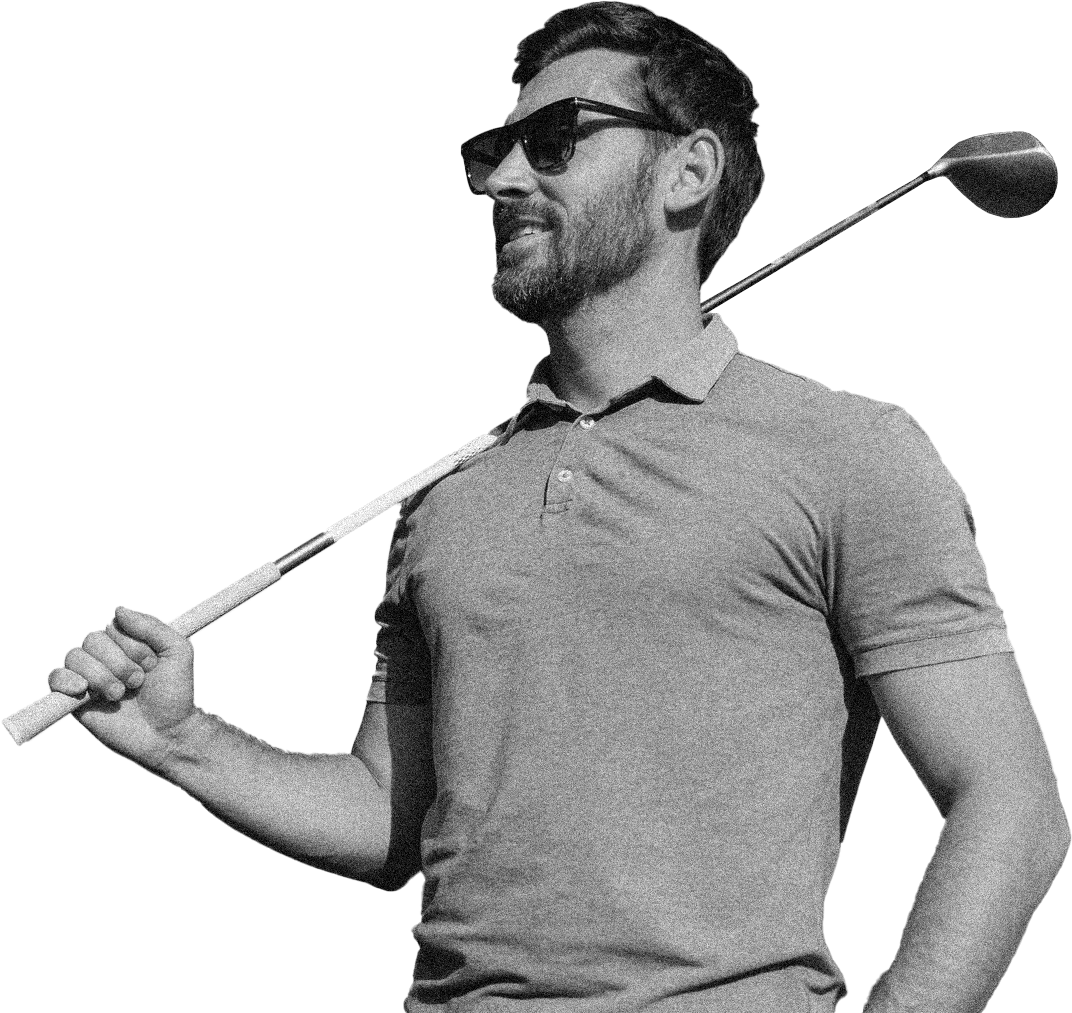What do you think about when you’re on the tee box of a par 5? I bet you’re thinking of bombing a drive and going for the green in 2! But what if that plan doesn’t happen? Does your “Plan B” include how you’ll play your third shot on a par 5? Your third shot on a par 5 is pivotal. When someone searches for golf instructors near me and picks John Hughes Golf to help them with their third shot to a par 5, we’re going to cover all the items within this blog post and more. Allowing all our clients to play to their potential when playing par 5’s.
The Pivotal Third Shot on a Par 5: The Case Scenarios
On a par 5, your third shot is your make-or-break moment. Why?
Your third shot on a par 5 sets up the birdie putt you’re craving. Or, even an eagle attempt. But it can also rescue you from sure disaster and scoring worse than par. On a hole that par should be the highest number you put on your scorecard, what you do with your third shot is critical to your overall score for the round. Let’s dive into a couple case scenarios that show why your third shot on a par 5 is so important. And how you can make it count.
When Your Third Shot on a Par 5 is an Eagle Opportunity
We’ll start with the best-case scenario. The one all golfers starve for. And one of the fun times you’ll experience on the golf course. Your third shot on a par 5 setting you up for a chance at an elusive eagle. Highly skilled golfers experience this opportunity more often than high handicappers. But regardless of skill level, most of the time when blessed with an eagle attempt, you’re probably facing the taunting task of making a long putt. Requiring skilled touch with controlling your putt and the distance it travels.
How do you convert this long putt to an eagle? By practicing your lag putting. Knowing that making a putt of 40 feet or more is a bonus. Consult the odds provided by the PGA Tour or Arccos. Making a 40-footer at any skill level is difficult. But being able to control the distance your putt rolls can make a birdie a sure thing. Isn’t it a warm feeling when you leave yourself a tap in for birdie?
When Your Third Shot on a Par 5 is a Birdie Maker
The next best thing that can happen to you on a par 5 is staring at a short approach shot to the green with a chance of making a birdie. Or, the aforementioned tap in after an eagle attempt.
You’ve succeeded at hitting a long enough drive that’s in play to hit a longer club close to the green. Setting up a scoring iron for your third shot. This is where you capitalize on any par 5’s generosity.

This is a huge moment for beginners and intermediate golfers. For that matter, for all golfers. Par 5’s are statistically where golfers score the best. On the PGA Tour, the top players make birdie or better on over half their par 5’s. That’s because a well-executed third shot leads to a makable putt.
Even for us as mere mortals, par 5’s are our best chance to write a red number on the card. Your third shot is the one that sets up the birdie opportunity. All the 300-yard drives in the world don’t matter if you chunk your wedge. Or sail the green with your third shot approach.
First Putt Length = Birdie Chances
Here we go again with controlling the distance of your first putt. But this time to convert the birdie chance. A stat worth mentioning is the average first putt length on the PGA Tour is 28 feet. Are you on tour? What is the average first putt length you have when hitting a green in regulation? You should know this stat and practice your putting skills from that distance all the time.
Your third shot on a par 5 is like a delivery service for your birdie putt. Knock your third shot inside 10 feet and the odds of you converting the putt skyrocket. But if you’re 28 feet or more away par is a great score on any par 5!
Another Revealing Stat
Dave Pelz, one of the game’s best at understanding and teaching the short-game, provided some interesting thoughts regarding approach shots. His research proved that 80% of shots lost to par by amateur golfers occur inside 100 yards. Meaning, you must practice your third shot on a par 5 more often. Because I bet most of the time when faced with a positive opportunity on a par 5, your third shot is within 100 yards. Rest in Peace Dave!
When Your Third Shot on a Par 5 is a Par Savior
Now it’s time to face reality. For the average amateur golfer, not every third shot on a par 5 is a pretty wedge from the fairway. Sometimes it’s more of an “uh-oh” scenario. You’ve been in the trees, deep rough, or another adverse condition that makes your third shot on a par 5 all about damage control. Or you’re re-teeing because your tee shot found the out of bounds marker. Saving your par and limiting the odds of you scoring worse.
Par 5’s lure average golfers into thinking “birdie or bust!” Smart and better than average golfers think “par is fine, eliminate the big number.” If you’re in trouble, your third shot on a par 5 is your chance to get back on track. Hit the smart shot that gets you on or near the green, and you can still save par. Miss it, and you might be looking at bogey or worse. The worse thing you can do is force the “hero shot” thinking it will avoid the blow-up hole. All too often, it is the cause of your blow-up holes.
Tiger Woods famously dominated par 5’s. Not by obsessing over eagles and birdies. But by avoiding mistakes. During his peak, Tiger averaged an astonishing 4.4 strokes on par 5’s. What was his secret? The core goal of “no bogeys!” Which meant making smart decisions with the crucial third shot. The lesson in this example is you being smart about how you’ll play your third shot on a par 5.
The Bogey Avoider Mindset
Instead of “I need a birdie here,” why not think “I’m not making worse than par here”? Doing so frees you up to take your medicine when needed.
If you had to lay up on your second shot, embrace your third shot with a wedge as a chance to hit the green and two-putt for a solid par. If you’re hitting your third shot on a par 5 from gnarly rough or a bunker, focus on getting the ball to a safe spot. On the green! Or somewhere you can comfortably get up-and-down.
Sometimes that means playing your third shot on a par 5 conservatively. To eliminate disaster. Par 5’s often has tempting risk-reward setups. Like a reachable green guarded by water. Or a wide-open look at a green that is hiding a penal situation behind it. Making it likely your third shot decision determines if you walk off with an easy par or a round-wrecking double bogey or worse.
Confidence Under Pressure
Pulling off a great third shot on a par 5 when you’re in trouble can be a huge momentum boost. Think about it. You’ve hit two poor shots. You’re frustrated and rattled. But you compose yourself. You hit a clutch pitch or chip. And suddenly you’re putting for par.
That’s essentially an emotional 180°! From panic to fist pump! It proves to you that you can recover. Which makes you a more resilient golfer. A great up-and-down on a par 5 after chaos is often more satisfying than a routine two-putt birdie. It’s a reminder that golf isn’t about perfection, it’s about the next shot.
On the flip side, if you let the pressure get to you it can bleed into subsequent holes. If you skull that pressure pitch over the green. Or chunk it. You’re digging a deeper hole to climb out of. That’s why practicing these third-shot scenarios is so important for your mental game. You want to step into each third shot on a par 5 believing you can knock it close. No matter what the situation.
The Stats Don’t Lie: Third Shot on a Par 5 Impact by the Numbers
Let’s bolster the case with some data. Numbers show just how crucial your third shot on a par 5 really is:
- Birdie Conversion Rates: Par 5s offer the best birdie rates. On the PGA Tour, players average scores on par 5’s is 4.6. For amateurs, par 5’s are typically the only holes where you might realistically beat par. The third shot is your primary birdie conversion tool. No matter how far you hit your drive, you still need a great third shot to capitalize.
- Greens in Regulation from 175 yards or Less: According to Arccos data analysis, your chances of hitting the green go way up once your approach is under 175 yards. In fact, an analysis of millions of amateur shots by Arccos found that greens hit percentage increases significantly as you get closer to the hole, especially inside 175 yards.
This implies that if you want your third shot to a par 5 to find the green, you should try to get your second shot as close as safely possible. The old “lay up to 100 yards” theory doesn’t hold up statistically. You’re usually better off being 70 yards away than 120 yards away, for instance.
- Average Proximity on Wedge Shots: Pros average ~18 feet from 100 yards and ~15 feet from 50 yards. That means on a good day you’re looking at a 10–15-footer for birdie.
Translation: Don’t get upset if your third shot isn’t “stiff.” Instead, consistently practice hitting the green and give yourself a putt. A lot of amateur bogeys on par 5s come from missing the green with the third shot. Turning a likely two-putt par into a scrambling situation.
- Scrambling/Up-and-Down Stats: Sometimes your third shot on a par 5 is a scramble. Whether it be chipping from just off the green. Or a greenside bunker shot. PGA Tour players average up-and-down percentage is roughly 56%. From the rough around greens, that drops to about 50%.
If you miss the green with your third shot, your odds of still making par are even less. That’s why hitting the green or getting on in 3 from anywhere around the green is so important. Every time you do, you tilt the odds in your favor of a two-putt par at worst. Two putts for par on a par 5 is never a bad thing.
Statistics reinforce what your gut might already tell you. Mastering the third shot on par 5s is a direct path to scoring better. Unlike driving distance or pure ball-striking, this is an area every golfer can improve with smart practice and strategy.
Drills and Practice Tips for Mastering Your Third Shot on a Par 5
Improving your third-shot on par 5’s performance takes practice. Not just any practice, but specific practice. The good news is that working on this part of your game can be fun and hugely rewarding. Here are some drills and tips to sharpen those wedges and pitches, and to prepare you for pressure situations:
1. Wedge Ladder Drill (Distance Control): This is a classic drill for honing your feel from various yardages. Pick a target on the range at 50, 75, 100, and 125 yards. “Ladder” your shots by hitting one ball to each target with the goal to land each ball as close as possible. This drill develops the ability to hit different distances on command. To gamify it, give yourself a goal: e.g. you must land 3 out of 5 balls in a 10-foot radius at each station before moving on. This drill is great for dialing in common third-shot yardages, while revealing layup ranges you’re best at.

2. Random Lies Practice (Get Out of Your Comfort Zone): Don’t just practice from perfect fairway lies – simulate the tough situations you’ll face for third shots. Drop balls in the rough, in bunkers, on downslopes, sidehills, etc. For each, play it as your “third shot” to a flag or target. This will teach you adjustments: e.g., how to hit a high shot off a downhill lie or how to pick it clean from thick rough. The concept, approach all your third shots to par 5’s as if you have no fear. Because you’ve hit these shots before
3. One-Ball Up-and-Down Challenge: Toss a single ball into various tricky spots around a green (bunker, deep rough, awkward distance) and see if you can get up-and-down in two shots. Keep score (e.g., 1 point for a successful up-and-down). Compete with a friend or try to beat your own record. This simulates the pressure of having only one chance, just like on the course.
4. Par-5 100-Yard Challenge: Next time you’re on an empty hole, pick a spot about 100 yards out. Drop 10 balls. And find out how many times you can hit the green. And how many times your shots are within 15 feet of the hole. Track your results. Do this regularly and watch the improvement. To add pressure, set a goal of needing 6 out of 10 inside of 15-feet before you can go home. Or 10 out of 10 within 25 feet or you have to do 20 push-ups. Placing circumstances on your results makes practice fun and gets you used to the pressure you place yourself in on the course when it matters.
5. Play Par-5s with a Strategic Twist: An on-course practice idea is playing all par 5 holes to lay up for a third shot. Even if you hit a monster drive, discipline yourself to lay up to a good number, then treat your third shot on a par 5 as if it were to win The Masters. Doing so, you remove any temptation of miracle second shots. And you work on honing your wedge game. You’ll surprise yourself when you realize how many more realistic chances you have of converting a birdie on any par 5. As well as how many times you walk off the green with a par.
6. Pressure Putting from Birdie Range: Converting a great third shot on a par 5 also means making a putt! Don’t neglect putting practice. Especially within the 5 to15-foot range, where most of your birdie opportunities exist. A good drill to accomplish this is “ladder putting drill” where you set tees at 5, 10, 15 feet and try to make all putts. Your goal with this drill is to become automatic from inside 5 feet. And a better than average putter from 10 to 15-feet. The more confident you are from these distances, the less pressure you feel when faced with these putts.
By incorporating these drills, you’ll develop the finesse, creativity, and consistency needed to ace your third shot on a par 5. Track your progress over time. Maybe your up-and-down percentage from 50 yards goes from 20% to 50%. Or your average proximity from 100 yards improves by a few feet. These small gains will absolutely show up on the scorecard as more pars and birdies on par 5s.
Remember, always practice with purpose. If you’re a client of John Hughes Golf, you know that is a point of emphasis. And if you practice your third shots on par 5’s diligently, you can trust your skills on the course.
Conclusion
Your third shot on a par 5 might not feel as exhilarating as hitting a 300-yard drive. But it is the linchpin that connects your long game to your short game. Execute it well, and you’re either setting up a birdie or taking the steam out of a potential bogey. Mess it up, and no matter what came before, you’re suddenly scrambling.
Next time you’re standing over that wedge or pitch for your third shot on a par 5, embrace it! Don’t see it as a stress point. See it as your moment to shine. This is the shot that can ignite your round with a birdie. Or save the day with a clutch par. Stay calm, pick your target, and swing with confidence.
By understanding its importance, practicing for it, and approaching it with the right strategy and mindset, you’ll turn any third shot on a par 5 into a true weapon in your game. And as your scores start dropping, you’ll smile knowing that the key was mastering the one shot most golfers overlook.
Want to learn how to make your third shot on a par 5 your best weapon? The contact John to schedule a Custom Coaching Session or Golf School.






